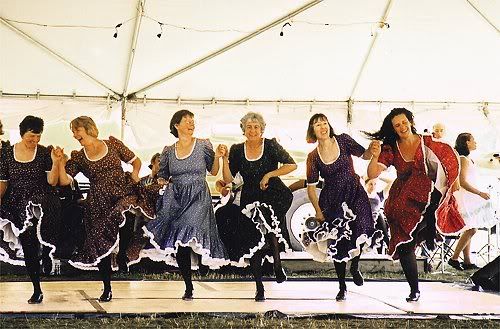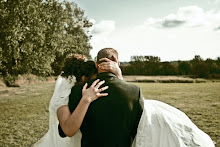Last night we watched a very good movie called "Mrs. Miniver" .
It was made during WWII and was a great morale booster. Winston Churchill said that this moive helped Britian more than a fleet of destroyers.
Tuesday, August 30, 2005
Mrs. Miniver
Posted by Mrs. S at 12:34 PM 1 comments
Labels: movies
Saturday, August 27, 2005
You can help!
Even if you aren't able to adopt children in need, you can still help! Help the children of Acres of Hope Orphanage by collecting, and sending them much needed items. You can find a list of their needs HERE. 

Pcitures from Acres of Hope Liberia
Posted by Mrs. S at 8:14 AM 0 comments
Wednesday, August 24, 2005
Saturday, August 20, 2005
Appalachian Clogging
Recently my sister and I have taken an interest in Appalachian clogging. We got a video from the library called, "Beginning Appalachian Clogging; A Lark in the Morning video lesson"
Here we go.......!
www.fiddlekicks.com
Here's an article I found on-line,
Cloggers shuffle and skip
to save Appalachian tradition
By Angela Charlton
The Associated Press
Charlestown, W.Va., June 1997
COAL MINERS do it. Librarians do it. Politicians do it. Some keep their feet barely on the floor, heels and toes thumping with dizzying speed, torsos virtually motionless. Others skip and stomp, or slap their thighs.
They’re clogging, and carrying on an old Appalachian tradition.
“You don’t need fancy clothes or fancy steps. It’s not important what you do, just that you keep time,” says Jane George, who spent decades teaching clogging and other mountain dance in rural schools.
Clogging and its kin are becoming more popular because of standardized steps and increasing interest in southern Appalachian heritage. The dances are no longer relegated to barns and back porches.
Millions watched a North Carolina clogging group kick and click at the 1996 Olympics in Atlanta. The Irish group Riverdance, with its modern version of the jig that inspired American clogging, earned a Grammy and a spot on this year’s Academy Awards program.
Rep. Bob Wise, D-W.Va., clogged his way to Capitol Hill. Wise is often called “The Clogging Congressman” for dancing through campaign events and small-town parades.
“A woman once said to me, ‘I’d rather see you clog for one minute than listen to you talk for 10,”’ Wise says. “I decided I’d take that as a compliment.”
He picked up his passion for clogging at a barn dance in a nearby hollow. He calls clogging “exhilarating, exhausting and the best aerobic exercise around.”
Appalachian clogging is a blend of dances brought by early settlers. The Irish and Scottish brought their jigs, the English came with their clogging, and blacks contributed their high-kicking buck dance. Some clogging steps include a stomp thought to come from Indians.
Their descendants melded those moves and have been doing their own to the tune of a fiddle or dulcimer, or to the hum of their own voices.
Clogging can be done in shoes with taps or without. It doesn’t require costly costumes or a college education.
Some call it flatfooting, step dancing, hoe-downing, back stepping. Older mountaineers just call it dancing.
“Clogging is something seen as more structured. Flatfooting is freer,” Mrs. George says. “You can watch a bunch of people flatfooting and they’ll all be doing something a little different.”
Christine Ballangee Morris, who teaches dance at festivals and dance theory at Ohio State University, says the difference is in the music. Brisk, banjo-picking bluegrass is for clogging, she says, while more percussive mountain music is better for flatfooting.
Others say the name of the dance isn’t important. Everyone says the important thing is having a good time.
“It’s a lot more fun than boring speeches,” Wise says.
At a recent West Virginia heritage festival, preschoolers hopped alongside mechanics, some melting into the music, others stumbling along in blissful oblivion to the beat.
“People danced to enjoy themselves, for a break from daily hardships,” Ms. Morris says. “They weren’t concerned with standardized steps.”
In fact, many cloggers still take pride in the distinct steps that vary from hillside to hillside, moves such as “Wringing the Chicken’s Neck,” “Stepping on a Snake,” and “Briar Patch.”
West Virginia is one of the last places to retain those differences, says Jerry Duke, a San Francisco professor who has written a book on Appalachian clog dance.
At least, for now.
“It’s a given that regional distinctions will continue to disappear,” Duke says. “It was inevitable once it became easier to navigate the mountains and people became less isolated.”
Traditionalists criticize competition clogging, saying its rigid rules threaten to suffocate individual styles.
“You lose the flavor and history of home-grown dances, like ‘Mr. Hilt Goes to the Mailbox,”’ Morris says. That dance mimics the unusual gait of a local man.
But standardization has made clogging marketable.
The Leather ‘N’ Lace Cloggers, based in Leicester, N.C., made it to last year’s Olympics’ entertainment with carefully choreographed stomps and cheery accessibility.
Mrs. George’s grandchildren are cruising the competition circuit. But that was not her main goal in teaching them how to dance.
She says she taught clogging to paint children a fuller picture of their mountain history, one that is not just of poverty, coal and isolation.
“It’s a part of Appalachia, but it’s not something to be ashamed of,” she says. “We understood that we had to start talking about (our history), and make kids feel proud of it instead of hiding.”
Mrs. George says Americans’ recent fascination with all things Irish has helped revive interest in Appalachian dance.
“I love to show people the Irish and Scottish dancing, but I always point out how it relates to our own mountain dancing, and then they start getting interested in that,” she says.
©1997, The Associated Press
Posted by Mrs. S at 5:17 PM 1 comments
Labels: dance
Friday, August 19, 2005
Which Edwardian Actress are You?

You are Phyllis Dare. You are a true woman with a
gentle, queit spirit, yet a good sense of
humour.
Take this quiz!
Which edwardian Actress are you? brought to you by Quizilla
Posted by Mrs. S at 8:18 AM 0 comments
Thursday, August 18, 2005
The Kentucky Long Rifle
My 8th Great Grandfather, Robert Baker, invented the Kentucky Long Rifle (originally known as the Pennsylvania Long Rifle). It was the deadliest weapon of it's time.
"Robert Baker married Mary Mollie Bowling who is believed to be from the same Bollin family with ties to Pocahontus, but not to Mary Mollie Bowling's line.
John "Renta" Baker, son of Robert & Mary Mollie Bowling, was one of the famous "Longhunters". Men who went west of the Blue Ridge Mountains for the first time on extended hunting & trapping trips. He was also a memeber of the "Cleveland Bull Dogs", who ran the Tories out of Wilkes/Ashe County, NC and surrounding areas just before the Revolutionary War." -Information in " " are written by BYRON BROWN
Posted by Mrs. S at 8:50 PM 0 comments
Labels: guns







